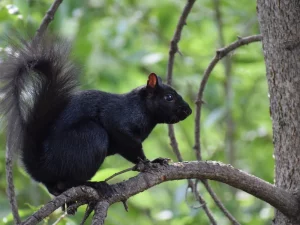Written by Isabella Scheibl, Land Management Intern
Over the past few weeks, we have seen the long-awaited addition of snow to our landscape, and not-so-waited signature temperature plummet of a classic Wisconsin winter. With this change in weather, there is also a shift in wildlife that I see around the Woodland Dunes intern house where I reside. Rabbit tracks seem to be everywhere, but the posse of Grey, Fox, and black squirrels that I constantly saw in the yard just a few weeks ago, seem to venture outside a little less frequently.
 You might say, “Wait a minute. A black squirrel? That’s not a species I’ve heard of around here!” That is because it is not a species. Our state is home to about seven out of the 280 squirrel species of the world. The Eastern Grey Squirrel, American Red Squirrel, the Eastern Fox squirrel, and Northern and Southern flying squirrel dwell in the trees. There are also several species of ground squirrels that reside in Wisconsin. Whether gliding through the air, dashing in the trees, or hanging out on the ground, not one of these species has entirely black fur. However, once in a while, individuals of both the Eastern Grey Squirrel (Sciurus carolinensis) and the Eastern Fox Squirrel (Sciurus niger) species have a genetic mutation that results in an abundance of the pigment chemical melanin. Thus the term “melanistic” is used to describe these individuals. The resulting hair is much darker than typical squirrel hair and creates a darker fur.
You might say, “Wait a minute. A black squirrel? That’s not a species I’ve heard of around here!” That is because it is not a species. Our state is home to about seven out of the 280 squirrel species of the world. The Eastern Grey Squirrel, American Red Squirrel, the Eastern Fox squirrel, and Northern and Southern flying squirrel dwell in the trees. There are also several species of ground squirrels that reside in Wisconsin. Whether gliding through the air, dashing in the trees, or hanging out on the ground, not one of these species has entirely black fur. However, once in a while, individuals of both the Eastern Grey Squirrel (Sciurus carolinensis) and the Eastern Fox Squirrel (Sciurus niger) species have a genetic mutation that results in an abundance of the pigment chemical melanin. Thus the term “melanistic” is used to describe these individuals. The resulting hair is much darker than typical squirrel hair and creates a darker fur.
While this phenomenon is rare, it does happen throughout the United States, Canada, and has spread to the United Kingdom. Early settlers to Two Rivers documented black squirrels. Even though only 1 in every 10,000 squirrels is born melanistic, the concentration of individuals with this trait is greater in some areas. The trait is thought to have originated within the Fox Squirrel species, and is spread through mating between Fox squirrels and Grey Squirrels. Due to their darker color, melanistic squirrels absorb more heat and are therefore possibly more adept at surviving in cold weather. When compared to gray squirrels, melanistic squirrels retain their body temperature 18% better. Although it is possible that this thermal advantage has contributed to the northern spread of gray squirrels over the span of thousands of years, this evolutionary proposal requires more investigation before it can be stated with certainty.
Researchers have studied melanistic squirrels on several occasions to see if they are unique beyond their pelt. Behavioral studies have examined aggression and territoriality in relationship to other squirrels, but no difference in behavior was documented between the melanistic squirrels and the typical colored ones.
Even though melanistic squirrels are better at weathering the cold, they still tend to hunker down for inclement weather just like their Grey and Fox counterparts. When these energetic little creatures decide it is balmy enough to forage, see if you can spot a unique squirrel. You will know one when you see it. You can bet I will be on the lookout.
Photo from the Smithsonian Magazine https://www.smithsonianmag.com/smart-news/interspecies-breeding-responsible-some-squirrels-black-coloring-180972921/
—
